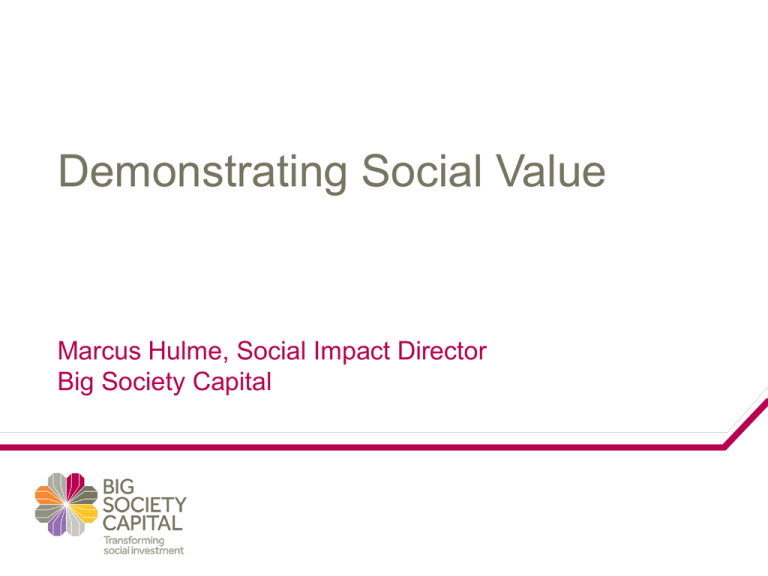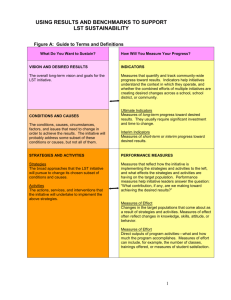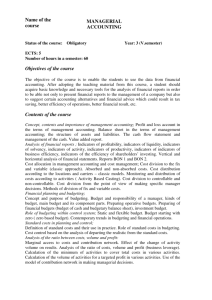Marcus Hulme Presentation
advertisement

Demonstrating Social Value Marcus Hulme, Social Impact Director Big Society Capital Overview 1. Building a social impact strategy. 2. Measuring social impact. 3. Communicating social impact. 4. Questions. Building a social impact strategy • • • Have you set clear indicators to measure change? How are you progressing? How are you learning and changing? • MISSION • • EVIDENCING IMPACT & LEARNING What problem do you want to address? What is the context and evidence? What change do you want to make and for whom? Does your mission reflect the need? OUTCOMES • • • What changes are you trying to achieve? Do your outcomes logically address the need? Are they realistic and achievable? ACTIVITIES • • • How do your activities reflect your mission and outcomes? Is there a clear ‘impact chain’ between your activities and outcomes? Have you involved beneficiaries in shaping your services? Planning social impact Aim or Mission Outcomes Activities, outputs or services Charities Evaluation Service PlanningTriangle (adapted) Example logic model N E E D / C O N T E X T Aim/ Mission Activities/Outputs To improve the physical and mental well being of older people who are socially isolated. • • • • Short term outcomes Long term outcomes • Run outreach work in care homes, GP practices and community centres to build customer base. • Improved physical and mental well being for older people in communities. • Deliver physical activity sessions in community settings and care homes. • • Organise reminisce sessions in community sessions and care homes. Older people feel less isolated from participating in engaging activities. • Reduction in the amount of falls and injury's for older people. • Greater awareness about the benefits of physical activity amongst health and social care practitioners. • Offer tailored one to one sessions for older people with specific support needs. • Measure the social impact of the service (for both individuals and as a whole) to refine approach and improve activities. Inputs Complete needs assessment in target communities, develop business plan including aims, outcomes, activities, timing, and governance structures. Secure finance from social investment funds. Recruit staff, volunteers and run induction and training sessions. Run promotional activities for service in community and launch. • Service that promote the physical and mental health of older people are replicated across the region. • Older people feel more happy and healthy through taking part in sessions. • Reduction in costs to health and social care budgets due to increase in physical and mental well being amongst older people. Indicators • • • • • • • Amount of physical activity amongst older people. Number of older people who report improved mental well being. % change in physical activity participation for older people. % reduction in falls for older people taking part in the service. Level of awareness about the benefit of physical activity for older people amongst practitioners. Level of health and social care expenditure on older people. Number of sessions delivered across region. Assessing social impact • What is the promise of change? Defined strategy, understanding need and context. Social Mission • What is the management of change? Mission Locks, Board suitability and exit. Governance • How will the organisation deliver the social mission? Management team, track record, extent to social impact performance mission is integral to financial success and visa versa. Activities Social impact Impact measurement • What is the extent of change that will be delivered? Depth and breath of impact, innovation and change, organisational development. • How will impact be assessed and measured? Impact assessment and screening, planning and targeting, monitoring and reporting, auditing and learning. Outcomes Matrix For the wider market… 1. Comprehensive and standardised framework for outcomes in the UK 2. Best practice tool for defining and evidencing impact For Big Society Capital and Intermediaries 1. Single framework for all SIFIs to use to identify, define, monitor and report their impact 2. Help evaluate potential deals 3. Standardise essential aspects of impact reporting 3. Collate impact information across out portfolio 4. Ensure transparency around our social assessment process 4. Monitor and report on BSC’s impact 5. Ensure impact assessment and strategy is rooted in an outcomes-based perspective Measuring social impact Homeless Long-term health issues, life threatening or terminal illness Living in poverty/are financially excluded Employment, training and education Voluntary carers Elderly (including those with dementia) Ex-offenders Learning disabilities or mental health needs Experienced crime or abuse Housing and local facilities Income and financial inclusion Vulnerable parents Long-term unemployed Vulnerable young people and NEETs Outcome Areas Physical disabilities or sensory impairment Physical health Mental health and well being Family, friends and relationships Citizenship and community General Public / All Arts, heritage sports and faith Conservation of the natural environment Vulnerable children Addiction issues Tracking progress Tracking progress • Indicators help you to understand the extent of change being achieved by your organisations and track progress. • Indicators should link to your outcomes and be specific, proportionate, practical, useful and relevant. • A good way to set your indicators is by asking yourself: how will we know the change is happening? • Methods to gather data include surveys, focus groups, observation and analysing secondary data, plus many more. • There are lots of existing indicators you can use from websites such as the Global Values Exchange: http://www.globalvaluexchange.org/ • A good impact measurement plan should include details of aim, outcome, activities, targets, methods of data collection, responsibility for data collection and frequency of reporting. Communicating and influencing • Identify who you are trying to influence. • Engage key stakeholders from the outset. • Use appropriate methods for measuring impact. • Be responsive to the external context. • Build on existing evidence. • Tailor findings and communications to different audiences. • Include case studies of beneficiaries. • Have a clear ongoing communications strategy. • Link evidence to the wider context. • Highlight cost savings/ benefit where possible. Summary Identify need, define mission, outcomes and indicators • Setting out your purpose • Proving you are making a change • Both qualitative and quantitative • Use of appropriate indicators Identify stakeholders • Baseline/comparis on group • Sampling • Involvement Gather data • Interviews • Surveys • Questionnaires • Focus groups • Case studies Track performance and communicate • Measure social performance against mission • Show change over time; acknowledge learning • Set new targets www.bigsocietycapital.com Big Society Capital Limited is registered in England and Wales at Companies House number 07599565. Our registered office is 5th Floor, Chronicle House, 72-78 Fleet Street, London EC4Y 1HY. Big Society Capital is authorised and regulated by Financial Conduct Authority number 568940.











